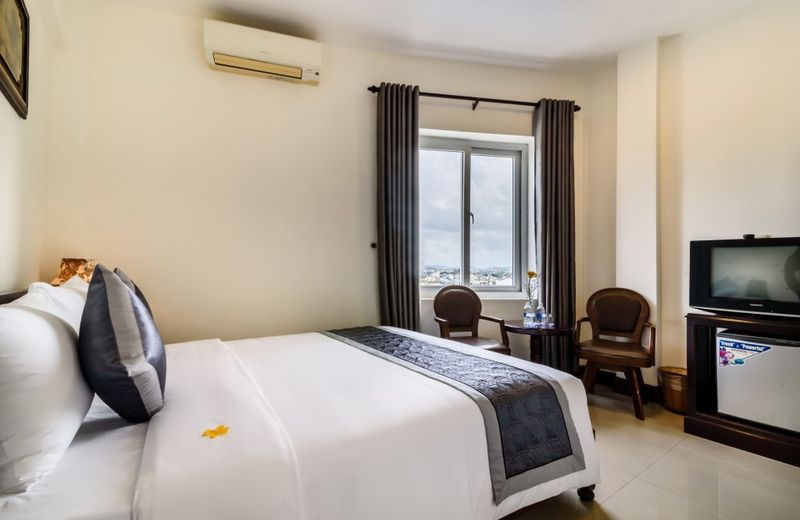Why choose this tour ?
Vietnam's Demilitarized Zone, or DMZ, is the area around the former border between North and South Vietnam. Historically it was a narrow band of terrain extending from the Laos border to the coast, five kilometres on either side of the Ben Hai River, roughly on the 17th parallel north of latitude. This deluxe full-day private tour will bring you to the area as well as the history of the Vietnam war. It’s a long day trip but regular stops at interesting places make it very manageable in a private car and tourguide.
What makes DMZ TOUR FROM HUE - Deluxe private tour fullday a unique experience ?
8:00 am, tour guide and driver pick you up at your hotel, transfer to Quang Tri. First stop is Quang Tri citadel on the bank of river Thach Han which was the site of fierce battles during the US war in Vietnam. Quang Tri was the place where several important military events took place between 1954 and 1971. But the climax, without a doubt, was the 81-day fight in the summer of 1972. In the 81-day fight, the US army and the southern Vietnamese regime mobilized a large number of troops and ammunition to capture the citadel. Heavy artillery fire during these 81 days virtually razed the citadel. Only a few parts of the citadel still stand.
Keep moving to the west, stop to visit the Rockpile, Dakrong Bridge, Ho Chi Minh trails on the way to Khe Sanh combat base – one of the violent battles in Quang Tri, one US base fell under attack in early 1968. You’ll also see the remaining of an old airfield. Visit the museum of Ta Con airport to see the things in nature of the fierce war.
The Bến Hải River (Vietnamese: Sông Bến Hải) is a river in central Vietnam which became an important landmark in the partition of the country into a northern and a southern zone along the 17th parallel by the Geneva Accords of 1954. The demilitarized zone (DMZ) separating the two parts extended about 5 kilometers (3.1 mi) from either side of the river. At the time of the partition, the principal north-south road (Highway 1) crossed the Bến Hải River over Hien Luong Bridge (also known as the "Peace Bridge"), a beam bridge built from steel by the French in 1950. After the partition, the northern portion of the bridge was painted red and the southern portion yellow. The bridge was damaged by American bombardment during the Vietnam War in 1967. After the Paris Peace Accords, a modern bridge was built next to the old bridge.
Vinh Moc (Vĩnh Mốc) is a tunnel complex in Quảng Trị, Vietnam. During the Vietnam War it was strategically located on the border of North Vietnam and South Vietnam. The tunnels were built to shelter people from the intense bombing of Son Trung and Son Ha communes in Vinh Linh county of Quảng Trị Province in the Vietnamese Demilitarized Zone. The American forces believed the villagers of Vinh Moc were supplying food and armaments to the North Vietnamese garrison on the island of Con Co which was in turn hindering the American bombers on their way to bomb Hanoi. The idea was to force the villagers of Vinh Moc to leave the area but as is typical in Vietnam there was nowhere else to go. The villagers initially dug the tunnels to move their village 10 metres underground but the American forces designed bombs that burrowed down 10 metres. Eventually, against these odds, the villagers moved the village to a depth of 30 metres. It was constructed in several stages beginning in 1966 and used until early 1972. The complex grew to include wells, kitchens, rooms for each family and spaces for healthcare. Around sixty families lived in the tunnels; as many as 17 children were born inside the tunnels. The tunnels were a success and no villagers lost their lives. The only direct hit was from a bomb that failed to explode; the resulting hole was utilized as a ventilation shaft. Three levels of tunnels were eventually built.
Tour Description & Additional Info:
- Public transportation options are available nearby
- Infants are required to sit on an adult’s lap
- Suitable for all physical fitness levels
Options To Choose for Your Trip:
- DMZ TOUR FROM HUE - Deluxe private tour fullday
Add
Pickup included
Not Included
- Tip for tourguide and driver
Special Instructions:
Please be advised..
- This Tour is Provided by RESTOUR.
- Tour Timezone & Starts at Asia/Ho_Chi_Minh.
- Mobile or paper ticket accepted.
- For a full refund, cancel at least 24 hours before the scheduled departure time.
- This Tour is Rated 5 Stars based on 3 valid reviews on VIATOR.
- Minimum 1 Travelers is required to book.
- Maximum 12 Travelers is accepted for booking.
Add to wishlist.
Give this as a gift: Give the ones you love unforgettable travel experiences and make memories to last a lifetime.
Reserve now & pay later to book your spot and pay nothing today.
Free cancellation up to 24 hours before the experience starts (local time).










